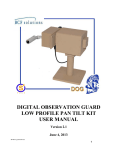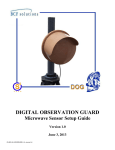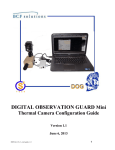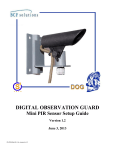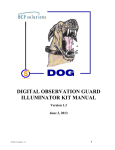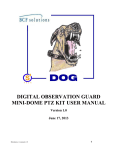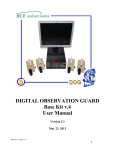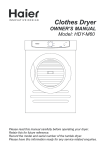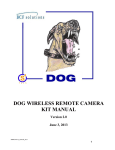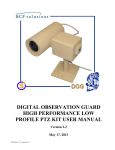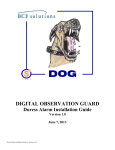Download ASP user manual
Transcript
DIGITAL OBSERVATION GUARD Mini THERMAL CAMERA KIT MANUAL Version 1.1 June 5, 2013 DMT-Kit-1/2_manual-v1.1 0 Table of Contents Mini Thermal Camera Kit Description ......................................................................................................... 2 Setting Up the Mini Thermal Camera .......................................................................................................... 3 Mini Thermal Camera Mounted on Remote Module ................................................................................... 3 Thermal Camera Separated from Remote Module ....................................................................................... 6 Tripod Mounting the Thermal Camera ..................................................................................................... 6 Wall Mounting the Thermal Camera ........................................................................................................ 7 Pole Mounting the Thermal Camera ........................................................................................................ 9 Connecting Separated Mini Thermal Camera to Remote Module ......................................................... 10 Mounting the Separated DOG Remote Module ..................................................................................... 11 Local Image Based Alignment of Cameras ............................................................................................ 11 Care & Maintenance ................................................................................................................................... 12 Troubleshooting .......................................................................................................................................... 13 Contact Info/Tech Support ......................................................................................................................... 13 Replacement Parts ...................................................................................................................................... 13 Table of Figures Figure 1: DOG Thermal Camera Kit with Military Case ............................................................................ 2 Figure 2: DOG Thermal Camera Kit Identification Label .......................................................................... 2 Figure 3: Collocated Mounting Assembly Parts .......................................................................................... 3 Figure 4: Surface Mounting DOG Remote Module with Wood Screws ..................................................... 4 Figure 5: Pole Mounting DOG Remote Module ......................................................................................... 4 Figure 6: Attaching Mini Thermal Camera to Mounting Bracket ............................................................... 5 Figure 7: Attaching Mini Thermal Camera Cable to Remote Module ........................................................ 5 Figure 8: Adjusting the Camera’s Tilt and Rotation ................................................................................... 6 Figure 9: Mini Thermal Separated Mounting Assembly Parts .................................................................... 6 Figure 10: Mini-Thermal Camera Mounting Bracket Assembly ................................................................ 7 Figure 11: Attaching Mini-Thermal to Tripod ............................................................................................ 7 Figure 12: Installing Mini-Thermal Camera Bracket to Wall ..................................................................... 8 Figure 13: Installing Mini-Thermal ‘U’ Bracket ......................................................................................... 8 Figure 13: Mounting Mini-Thermal Camera to Wall ................................................................................. 9 Figure 14: Installing Mini-Thermal Camera Bracket to Pole ...................................................................... 9 Figure 15: Installing Mini-Thermal Camera to Bracket ............................................................................ 10 Figure 16: Mini-Thermal Cable Connection ............................................................................................. 10 Figure 17: Connecting Mini-Thermal to DOG Remote Module ............................................................... 11 Figure 18: Mounting the DOG Remote Module........................................................................................ 11 Figure 20: Camera Alignment with Local Monitor ................................................................................... 12 DMT-Kit-1/2_manual-v1.1 1 Mini Thermal Camera Kit Description The DOG Thermal Camera Kit provides rugged small form factor thermal cameras for covert zero-light operations with the DOG system. The thermal cameras allow for covert viewing of personnel in zero light conditions out to 50m, with vehicles at over twice that distance. The thermal cameras are environmentally resistant and connect to the DOG’s CAT-5 infrastructure in the same way as other DOG cameras. A DOG mini thermal camera can be mounted to the remote camera module or separated via a 20ft adapter cable. The DOG Mini Thermal Camera kit is an accessory kit for installation on the DOG Base Kit. Each thermal camera kit consists of two DOG Remote Camera Modules along with two mini thermal cameras and their associated hardware as shown in the figure below. Note** There is also a single camera kit. Figure 1: DOG Thermal Camera Kit with Military Case Each case can be identified by a decal just above the handle as shown in the figure below Figure 2: DOG Thermal Camera Kit Identification Label DMT-Kit-1/2_manual-v1.1 2 Setting Up the Mini Thermal Camera Each rugged mini thermal camera module is connected to the control station via a single standard CAT-5 cable which delivers both video and power up to 500m. Power to the mini thermal camera modules is provided via the DOG Base Station. Installation of the mini thermal camera requires mounting the remote camera module to a wall, pole, or surface, and connecting a single standard CAT-5 cable with RJ-45 connector through the weather-resistant connector. Then mount and connect the mini thermal camera to the remote camera module using either the 2ft (local) or 10ft (remote) thermal camera cable. Once connected, the user will be able to display and record live video, and perform motion detection for the thermal camera through the DOG Base Station. Mini Thermal Camera Mounted on Remote Module For collocated mini thermal camera mounting begin by unpacking the Remote Camera Module with the attached tripod, mini thermal camera, ‘U’ mounting bracket, 2ft cable, and mounting hardware as shown in the figure below. Figure 3: Collocated Mounting Assembly Parts Select the mounting type for the Remote Camera Module, options include wall, surface, or pole mounting. For a sturdy wall or surface mount screw the Remote Camera Module into the surface using the appropriate type of screws for the specific surface material as shown in the figure below. For cement surfaces use the provided ¼” masonry drill bit to drill a hole in the cement and hammer in a screw anchor before using the provided screws to secure the DOG Remote Module to the wall. Insure that all four screws are through the upper and lower mounting holes, making sure that the Remote Camera Module is firmly mounted before attaching the thermal camera. DMT-Kit-1/2_manual-v1.1 3 Figure 4: Surface Mounting DOG Remote Module with Wood Screws The DOG Remote Module may also be mounted to a pole using two wire ties. Run the wire ties through the two holes at the top and bottom of the DOG Remote Module and around the pole. Make sure the wire ties are pulled tightly so that the DOG Remote Module is securely attached to the pole prior to attaching the mini thermal camera. Figure 5: Pole Mounting DOG Remote Module Next slide the mounting bracket onto the mini-thermal camera, as shown below. Align the two captive fasteners on the bracket with the screw holes on the camera. The mini-thermal camera contains an anti-cross thread protection, which requires a significant amount of force to be applied to the captive fastener while tightening. Tighten the captive fasteners until the mini-thermal camera is no longer easily able to rotate inside the bracket. Screw the bracket with the attached mini thermal camera onto the tripod ball head mounted atop the Remote Module until the bracket bottoms out on the ball head screw and can no longer be tightened. DMT-Kit-1/2_manual-v1.1 4 Figure 6: Attaching Mini Thermal Camera to Mounting Bracket Next, attach the power/interface cable to the mini-thermal camera. The cable connector is keyed so that it can only fit on the mini-thermal camera one way. The cable connector is also marked with a white dot, which will be visible from the rear of the camera, to aid in proper attachment. The connector will snap into place once it is fully seated. Lift the small protective cover from the 3-pin power/video connector on the side of the Remote Camera Module as shown in the figure below. Grasp the power/video camera cable and line up the 3-pin male connector with the 3-pin female connector on the side of the Remote Camera Module. Push the cable connector into the Remote Camera Module connector and twist the locking ring on the edge of the cable connector clockwise to fasten it. The Thermal Camera Module is now ready to be connected to the DOG Base Station (refer to DOG Base Kit User Manual). Figure 7: Attaching Mini Thermal Camera Cable to Remote Module The thermal camera’s tilt and rotation angle can be adjusted by loosening the knob on the side of the ball head and adjusting the thermal camera’s orientation and retightening the ball head screw. DMT-Kit-1/2_manual-v1.1 5 Figure 8: Adjusting the Camera’s Tilt and Rotation Thermal Camera Separated from Remote Module For covert or separated mini thermal camera mounting, begin by selecting which installation type will be used (tripod, wall, or pole mounting). Begin by unpacking the Remote Camera Module (remove ball head), mini thermal camera, ‘U’ mounting bracket, 10ft cable, and mounting hardware as shown in the figure below. Figure 9: Mini Thermal Separated Mounting Assembly Parts Tripod Mounting the Thermal Camera For a tripod mount, slide the mini-thermal mounting bracket onto the mini-thermal camera, as shown below. Align the two captive fasteners on the bracket with the screw holes on the camera. The minithermal camera contains an anti-cross thread protection, which requires a significant amount of force to be applied to the captive fastener while tightening. Tighten the captive fasteners until the mini-thermal camera is no longer easily able to rotate inside the bracket. DMT-Kit-1/2_manual-v1.1 6 Figure 10: Mini-Thermal Camera Mounting Bracket Assembly With the mounting bracket securely fastened to the mini-thermal camera attach the mini-thermal camera and bracket to the tripod by loosening the thumbscrew and then screwing the ball disk screw into the bracket base as shown below. Once the bracket is tight on the tripod, adjust the thermal camera to the proper viewing angle and retighten the tripod thumbscrew to secure the mini-thermal camera in place. Figure 11: Attaching Mini-Thermal to Tripod Wall Mounting the Thermal Camera For a sturdy wall or surface mount, screw the mini-thermal camera wall/pole mounting bracket into the surface using the appropriate type of screws for the specific surface material. For cement surfaces use the provided ¼” masonry drill bit to drill a hole in the cement and hammer in a screw anchor before using the provided screws to secure the DOG Remote Module to the wall. Once the bracket is securely fastened to the wall, screw on the tripod ball head onto the brackets threaded stud. DMT-Kit-1/2_manual-v1.1 7 Figure 12: Installing Mini-Thermal Camera Bracket to Wall Next attach the mini-thermal ‘U’ bracket by aligning the cameras threaded holes with the mounting bracket’s captive fasteners and tighten the screws as shown below. The notches on the ‘U’ bracket should be facing downwards. The mini-thermal camera contains an anti-cross thread protection, which requires a significant amount of force to be applied to the captive fastener while tightening. Continue to tighten the captive fasteners until the mini-thermal camera is no longer able to easily tilt inside the bracket. Figure 13: Installing Mini-Thermal ‘U’ Bracket Next attach the ‘U’ bracket and mini-thermal camera assembly to the tripod ball head as shown in the figure below. Loosen the thumbscrew on the tripod ball head to adjust the mini-thermal cameras viewing angle and retighten once the camera is in its final viewing position. DMT-Kit-1/2_manual-v1.1 8 Figure 14: Mounting Mini-Thermal Camera to Wall Pole Mounting the Thermal Camera Place the mini-thermal pole mounting bracket flush against the pole mounting surface. Use a pair of wire ties to securely fasten the mini-thermal camera bracket to the pole. It is important to insure the wire ties are pulled tight to prevent the bracket and mini-thermal camera from sliding down the pole. Then attach the tripod ball head to the threaded stud sticking out of the pole mounting bracket. Figure 15: Installing Mini-Thermal Camera Bracket to Pole After attaching the mounting bracket to the pole align the mini-thermal cameras mounting holes with the ‘U’ mounting bracket’s captive fasteners and tighten the screws as shown below. The mini-thermal camera contains an anti-cross thread protection, which requires a significant amount of force to be applied to the captive fastener while tightening. Continue to tighten the captive fasteners until the mini-thermal camera is no longer able to easily tilt inside the bracket. Next attach the mini thermal camera to the tripod ball head adjusting the thermal camera as necessary by loosening the thumbscrew on the side of the tripod ball head. DMT-Kit-1/2_manual-v1.1 9 Figure 16: Installing Mini-Thermal Camera to Bracket *** IMPORTANT*** The thermal camera contains very sensitive electronics, which are not intended for viewing of direct or indirect (reflected) sunlight. The unit is intended for non-horizon exposure looking downward from the intended mounting plane. Exposure to sunlight, even for very short periods of time, may permanently damage the camera. Connecting Separated Mini Thermal Camera to Remote Module Once the mini thermal camera has been mounted or placed in its operational position, the power and signal connections need to be made. Begin by attaching the 10ft power/interface cable to the minithermal camera. The cable connector is keyed so that it can only fit on the mini-thermal camera one way. The cable connector is also marked with a white dot, which will be visible from the rear of the camera, to aid in proper attachment. The connector will snap into place once it is fully seated. Figure 17: Mini-Thermal Cable Connection Attach the other end of the 10ft power/interface cable to the DOG Remote Module by removing the protective cap on the 3-pin Remote Module connector. Align the two connectors (key/keyholes) and insert the mini-thermal circular connector twisting the lock ring clockwise to securely fasten the two connectors as shown below. DMT-Kit-1/2_manual-v1.1 10 Figure 18: Connecting Mini-Thermal to DOG Remote Module Mounting the Separated DOG Remote Module If the mini-thermal camera is mounted to a wall, then the DOG Remote Module can be mounted to the same wall within the cable length of the mounted camera. This is accomplished by screwing in the base of the Remote Module into the wall with the appropriate (wood or concrete) screws as seen below. If the mini-thermal camera is tripod or pole mounted, then the DOG Remote Module can be mounted with wire ties to one of the tripod legs or pole sections using the pole mount technique as seen below. Figure 19: Mounting the DOG Remote Module Local Image Based Alignment of Cameras If your DOG kit includes an optional alignment monitor, then the cameras can be aligned based on the image that is seen. The monitor can be worn on the wrist or simply put down near the camera during alignment. Make sure the DOG Base Station is powered on, then connect the BNC cable from the viewing monitor to the BNC port on the Remote Module as seen below. Turn on the monitor and view the connected camera image. Depending on the particular camera and mounting type, use the procedures above to align and lock down the camera based on the image that is seen in the monitor. If your kit does not include the optional alignment monitor, use the same procedure with the DOG Base Station display monitor. DMT-Kit-1/2_manual-v1.1 11 Figure 20: Camera Alignment with Local Monitor *** IMPORTANT*** The thermal camera contains very sensitive electronics, which are not intended for viewing of direct or indirect (reflected) sunlight. The unit is intended for non-horizon exposure looking downward from the intended mounting plane. Exposure to sunlight, even for very short periods of time, may permanently damage the camera. Care & Maintenance • • • The optical surface of the thermal camera lens should only be cleaned when it is visibly dirty. Care should be taken to avoid touching the exposed lens face. Skin acid left behind with fingerprints can be damaging to coatings and lens substrates. o First use a jet of air or blow across the surface of the lens to remove any sand or abrasive particles before cleaning. o If oil, water spots, or fingerprints form on the optical surface, clean as soon as possible using a soft cloth and mild neutral soap diluted with lukewarm distilled water, followed by reagent grade isopropyl alcohol or acetone swab. o Dust can also be removed gently using an alcohol or acetone swab. Thermal Camera (whether powered On or Off) is not intended for viewing of direct or indirect (reflected) sunlight. The camera unit is intended for non-horizon exposure looking downward from the intended mounting plane. Exposure to sunlight, even for very short periods of time, may permanently damage the camera. The thermal camera unit is not intended to operate submerged in water. However, the thermal camera is designed to withstand exposure to rain or high humidity. DMT-Kit-1/2_manual-v1.1 12 Troubleshooting The camera does not operate when first connected to the CAT-5 cable: • Test the CAT-5 cable to see if it or the connector is bad • Use a known good piece of CAT-5 cable to test the camera. The camera image is blurry. • Visually inspect the camera lens for external dust or internal condensation. • If there is dust or condensation on the lens, use a lint free cloth or wipe to clean it off. The camera image is too dark or light on the screen and very little detail can be seen. Turn the brightness up/down on the DOG Base Station Monitor (per the DOG Base Kit user manual) until the image is sharper and more detail can be seen. Video image comes and goes on the monitor. Try moving the CAT-5 cable around near the connectors on both the camera end and the base station end. If the video fluctuates with the cable movement then the cable is going bad. Contact Info/Tech Support For questions or support, please see our website at: www.bcfsolutions.net or contact: [email protected], 703-956-9088. For user manual or other technical downloads go to the customer tab on the website and login with the following: user: customer password: 2004-S4Tech Replacement Parts The following replacement parts may be ordered for the DOG Pan-Tilt Kit. Credit card orders are accepted. Please contact S4 for order information. Part No. DRP-RTSU DRP-CAM-MT Description Rugged Remote Camera Module Thermal Camera DRP-CAM-MT-BK Mounting Bracket DRP-CAM-MT-CBL-10 10 ft Remote Thermal Camera Cable DMT-Kit-1/2_manual-v1.1 13















